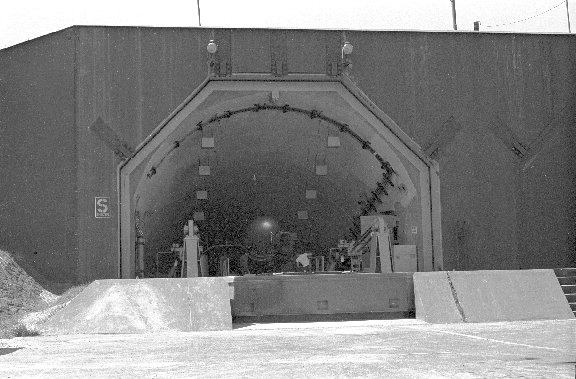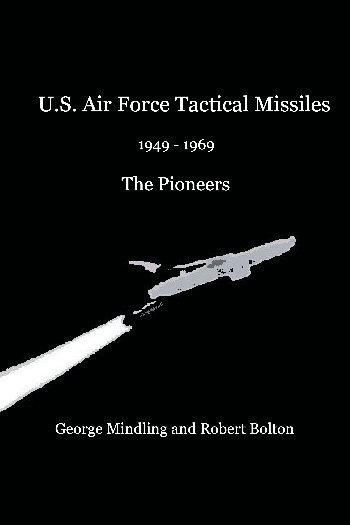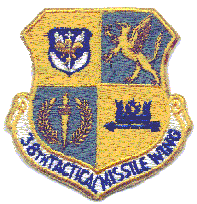|
Sembach Air Base
Hahn Air Base
Bitburg Air Base
Kadena Air Base
Osan AB
Tainan AB
Lowry AFB
Wheelus AB
Orlando AFB
Camp Happiness
Missile History I
Missile History II
Missile History III
The MM-1
Collectibles
Home Page
|
The Jammed Launch Door

"Airman Mindling, Airman Mindling, you have a phone call," the loudspeaker called out from the ceiling of the Bitburg Air Base NCO
Club. I was totally surprised as I had never been paged before in my life.
The first thing that raced through my mind as I headed for the office that
Saturday afternoon was that something had happened back stateside.
"Hello, this is Airman Mindling!"
"Mindling, this is Major Shaw, get out to Rittersdorf
and see what you can do to fix that damn launch door they jammed open. Get out there as soon as you can!"
"Yes sir, I'm on my way!" I had no idea what he was talking
about as I hung up, just that I had to take my fiancee (and future wife)
back to Bitburg or she would again have to wait on me for yet another site
dispatch. I raced across the street to our barracks and changed into fatigues in record time, and after dropping Ilse at her mother's apartment on Kyllburgerstrasse, was on my way to Site VII in my green, nearly clapped out 1954 VW.
I was absolutely floored that Major Shaw, Chief
of Maintenance for the 587th Missile Maintenance Squadron, called me, a two
striper, to fix a launch site facility problem. How he had picked me was
a mystery until I got the site, where, sure enough, one of the huge
launch bay doors was stuck about a third of the way up.
"You the hydraulics expert from Flight Controls?" one
of the launch crew members asked as I climbed the steps to inspect the
jammed door.
"Uhhh, yeah, I'm from flight controls," not wanting
to challenge the expert part of the statement. As I crossed to the inside
of the launch bay, I checked the huge pistons, then secondly, the control
arm that ran parallel and directly above the two silver, polished exposed pistons. Sure enough, jammed between the control arm bar, used as a sensing switch bar, and the huge, traveling piston arms, was a bent and thoroughly stuck, metal cased PSM-6 multimeter. Someone had been troubleshooting a circuit during the assembly of the missile that had just been loaded and
had thoughtlessly set the standard Air Force issue multimeter on the closest available shelf, the one that was formed by the pistons and the control arm. Then they forgot it was there.
Hours later, during the final phase of the missile acceptance,
the huge 100 ton door was to be raised and closed. The launch crew members in the launch bay,
usually including the crew chief, are in direct contact by headset with
the Launch officer 60 feet underground in the Launch Control Center. The
innocuous grey PSM-6 apparently escaped detection by the launch crew.
Apparently every thing had gone well until the door simply stopped.
The raising process is as exciting as watching grass grow, and takes almost as long.
It took a few moments to realize it had finally jammed. It was stuck just far enough up to prevent
a launch, and it couldn't be reversed to go back down.
I disconnected the switch leads, but they were for
the launch prevent position indicator and had no effect on the squealing
hydraulic unit. We tried to stop, reset, and even reduce the pressure to
the huge cylinders trying vainly to over power the jammed test set.
I had never seen the door system before, but simply tried to logically
figure out how to satisfy the signal requirements to stop the door drive
system. That didn't work, so we got a bigger hammer.
We tried knocking, then leveraging the case out
from between the arm and the piston to no avail. That was one PSM-6 that
was never going to be used again. Time was running out as a command decision
was made downstairs: blow the pressure and let the door down, one way or
another.
We all stood by on top and waited for the command, every
body standing well clear of the door and it's revetment. At first, it appeared
to be slow motion, but when it hit, it could have been heard all the way
back to base. It cracked the concrete between the two adjacent bays with
its impact. The door was open and the launch and AGE people were trying
to figure out how to straighten the control rod. That bay was out of commission
for a while, but at least the door was open.
When I went to see Major Shaw the next morning in the Chief
of Maintenance's office, he listened intently as I told him what had happened.
After a long pause, he said, "At least it's open!"
He finally managed a wry grin when I told him the PSM-6 wasn't one of
ours.
© George Mindling 1999 - All Rights
Reserved
|

The damaged revetment at Rittersdorf. The crack on the left had been semi-repaired and filled in, but the crack on the right side remained until Site VII shutdown in 1969. Photo courtesy of Bob Sosenko (rsosenk1@twcny.rr.com)
|

| |
I do remember the stuck door and I was there! I certainly don't remember all the details but as I recall we burst a hydraulic line in the power room trying to open that door. Being one of the smaller troops on crew, I got elected to be a gopher and crawl under the steel decking to clean up about 50 gallons of fluid. That actually turned out to be the easy part since everybody else was cleaning red fluid off the walls, ceiling and equipment. What a mess 3,000 psi can make in only a few seconds time..
Now, I'm really guessing here but if memory serves me right, there was a PSM-6 involved and I remember a light haired (maybe blonde), skinny dude (we all were back then..) working feverishly trying to figure out what some dumb-ass launch crew member did to a 100 ton door.....;-) That was you? I'll be damned. That's probably where you remember me from. I was a Mech 1 at the time but being trained in all positions except nukes, I and everyone else was in the bay at some point offering their two cents worth. We had to override the door interlocks so we could get access and that got the guards panties all in a bundle as I remember. When he saw 3 of us in the bay - all armed, he started breathing normal again and stopped hyper-ventilating over the two bay doors being opened (launch and access doors) after you fixed whatever it was.
Bob Sosenko (rsosenk1@twcny.rr.com)
71st TMS
|

U.S. Air Force Tactical Missiles
By the Editors of this Website!
|
Beyond the Web Page... The only book devoted exclusively to the Matador and Mace Tactical Missiles. The book reveals the story from the initial idea that became the first U.S. pilotless bomber, through the politically troubled development of the ever evolving deployment methods of the Matador and Mace Tactical Missiles. It covers the Units, Groups, Squadrons and Wing that fielded the missiles. From the United States test sites, Europe, Asia and North Africa nothing is omitted. All phases of the application of these two missiles by the U.S. Air Force (and West German Luftwaffe) are included, from the first tentative launches of the XSSM-A-1 Matador in January 1949, to the tense alert duty of the Cuban Missile Crisis, and the final launch of a MQM13A in May of 1977. The maintenance, logistics and launch, the men, equipment and tactics are all there.
|

|
"Bob, George, I finished your book 2 days after I received it. Couldn't put it down. It was incredible reading and incredibly detailed information."
Kent Washburn (KWASH55@aol.com) Mace B, Kadena, Okinawa
"George and Bob. I want you both to know how much I enjoyed reading and how much I admire and appreciate what you have accomplished in developing and publishing "The Pioneers". It is truly an outstanding piece of work, reflecting the time and effort required to produce it, but is also a formidable contribution to our military history. I mentioned in some earlier correspondence that I was a little disappointed in the relatively small amount of information regarding the Operating Location/Guidance Sites but you largely made up for it with this magnificent book."
Dale Lake (daleflake@yahoo.com) 601st Tactical Control Squadron, 38th TMW, Hamm, Germany
"I just finished your book, The Pioneers, et al. Please accept my "job well done!" Not only is it informative, but it's very readable. I'd also like to complement you on how well you footnoted it. You have shown that a scholarly work can be both instructive and enjoyable."
Michael Roof (lavinaschnur@hotmail.com) SGM USA (Ret.)
|

ISBN 978-0-557-00029-6
"Very good work with great detail."
Col. Charlie Simpson, USAF, Retired
Executive Director
Association of Air Force Missileers
"George, the book arrived on Tuesday while I was off to France. Of course, I quickly read the chapter about Germany's quiet step into the realm of nuclear armament. You know, this is still a widely ignored fact over here...
...For me it is fascinating to see what the picture really was in the 1950s and 1960s as opposed to what the official communication of the time wanted people to believe. A fascinating book shedding some light on the early days of tactical nuclear missiles as well as the political background that even today is still largely hidden behind the propaganda of the time. Can't wait to read the rest of it."
Burkhard Domke
Harsefeld, Germany
|
"I have your excellent book on USAF tactical missiles. I actually witnessed the decommissioning of the Maces at Wüüscheim back in 1966."
Paul Offen
Talitha, Tye Common Road
Billericay
Essex CM12 9PX
UK
"I just wanted to drop you a line and tell you how much I enjoyed the book that you and Bob wrote. The history was of particluar interest to me and my brother who was a history Professor at the University of Wisconsin. He also thought the book was well written, and he now knows what his little brother, (me), did while in Germany for three years."
George Joseph Snyder (gjsnyder@lanset.com)
71st TMS, Steinborn, Germany
"...by the way, I read your book, it was great, thanks for writing it."
Hack Hunton (hack@sstelco.com) Mace B, Kadena, Okinawa
|
|
US Air Force Tactical Missiles
© 2008 - George Mindling and Robert Bolton |
|
Inspired by the 38th TMW Website, George Mindling and Robert Bolton co-authored US Air Force Tactical Missiles 1949 - 1969: The Pioneers © 2008, the story of America's first operational missiles, from the Matador to the Mace, from Taiwan, Korea, and Okinawa to Germany, including Lowry, Orlando, Holloman, Santa Rosa Island at Eglin, and even Camp Happiness!
|
|
Dieses Buch ist ein Muss für alle, die im Rahmen ihres Dienstes bei der U.S. Air Force mit den frühen Marschflugkörpern
zu tun hatten, aber auch für deutsche Militärarchäologen, die in der Eifel, im Hunsrück oder im Pfälzer Wald schon
über rätselhafte Hinterlassenschaften gestolpert sind. Nach mehr als 40 Jahren wird endlich eine Fälle von Fakten,
Informationen und Geschichten zu den zwischen 1954 und 1969 in Deutschland stationierten, mit Automwaffen ausgerüsteten
amerikanischen Matador und Mace auf den Tisch gelegt.
Ausfährlich und lebendig erzählen George Mindling und Bob Bolton von den jungen Missilemen, die im März 1954 erstmals in Bitburg ankamen -
noch ganz grün im Gesicht, weil auf dem Atlantik schwerer Sturm geherrscht hatte. Von den T-33-Flugzeugen, die aus übungsgründen so taten, als
wären sie Matador-Flugkörper, äber die Startstellungen hinweg in Richtung deutsch-deutsche Grenze donnerten und sich von der Gegenseite
nur nicht erwischen lassen durften. Oder von der Kuba-Krise, als die US Air Force Europe auf DEFCON 3 ging und an die Mechaniker in
Bitburg Munition für ihre Karabiner ausgegeben wurde.
Augenzeugen sagen dazu: "Wir hätten die Vögel auf jeden Fall innerhalb von 15 Minuten in der Luft
haben müssen!" Es ist lebendige Militärgeschichte, die nun nicht der Vergessenheit anheimfällt, sondern
jedermann zugänglich wird - auch für die ortsansässige Bevökerung, die heute endlich erführt, was sich damals
in ihrer Nachbarschaft zugetragen hat. Den beiden Autoren gebührt der Dank.
Klaus Stark (klaus_stark@t-online.de)
Berlin, Germany
This book is not only a must for all those who served in the U.S. Air Force with the early cruise missiles, but also for German military archeologists who have been puzzling over relics stumbled across in the Eifel, the Hunsrück and the Palatinate Forests. After more than 40 years, we finally have a wealth of facts, information and stories, from 1954 to 1969, of the nuclear equipped American Matador and Mace missiles stationed in Germany placed on the table.
With detailed and vivid descriptions, George Mindling and Bob Bolton talk about the young Missilemen who arrived for the first time in March, 1954, in Bitburg - still green in the face, having prevailed the Atlantic crossing in major storm. Of the T-33 aircraft which practiced as if they Matador missiles launched in the direction of German-German border, or from the Cuban missile crisis, when the U.S. Air Force Europe went on DEFCON 3 and was issued ammunition to the mechanics in Bitburg for their rifles. Eyewitnesses say: "We would have to have the birds in the air in any event within 15 minutes!"
It is vital military history that is prey to oblivion, but is now accessible to everyone - even for the local population, which today finally learns what happened at that time in their neighborhood.
The two authors deserve thanks for saving the history.
Klaus Stark,
klaus_stark@t-online.de
Berlin, Germany
|
|

This page is in no way sponsored or endorsed by the United States Air Force.
Opinions and views expressed are those of the author and not necessarily those of the
Department of the Air Force.
|
Web Page Design and Development by
George Mindling - Port Charlotte, Florida
© George Mindling - 2003-2006 All Rights Reserved
|
|



